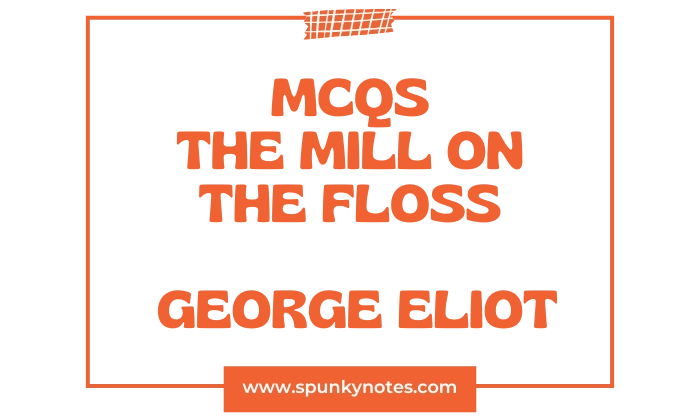

Estimated Reading Time: 21 min
The Mill on the Floss MCQs
1. In which year was The Mill on the Floss first published?
A. 1855
B. 1860
C. 1865
D. 1870
2. What are the first names of the two Tulliver children who are the novel’s central characters?
A. Luke and Lucy
B. Tom and Maggie
C. Stephen and Philip
D. Bob and Bessy
3. What is the name of the river that flows past Dorlcote Mill?
A. The Ripple
B. The Avon
C. The Floss
D. The Trent
4. Which character is the miller and proud owner of Dorlcote Mill at the start of the novel?
A. Mr. Deane
B. Mr. Riley
C. Mr. Glegg
D. Mr. Tulliver
5. What is Maggie’s most notable and defining physical feature as a child?
A. Her blue eyes
B. Her blonde, curly hair
C. Her dark, unruly hair and dark eyes
D. Her pale complexion
6. What is the main educational resolution Mr. Tulliver makes for Tom?
A. To make him a miller and farmer.
B. To apprentice him to Lawyer Wakem.
C. To send him to a good school.
D. To send him abroad to study.
7. What is the name of the lawyer whom Mr. Tulliver frequently mentions as his rival and adversary?
A. Mr Glegg
B. Mr Riley
C. Lawyer Wakem
D. Mr Pivart
8. Mr. Tulliver confesses to Mr. Riley that he chose his wife Bessy for what specific intellectual quality?
A. Because she wasn’t too clever.
B. Because she was clever at domestic affairs.
C. Because she was as clever as her sisters.
D. Because she was clever enough to handle lawyers.
9. What is the name of the clergyman whom Mr. Riley recommends as a suitable tutor for Tom?
A. Mr Stelling
B. Mr Jacobs
C. Mr Timpson
D. Mr Gore
10. After being told her unruly hair would not curl, what specific act of rebellion did Maggie perform in frustration?
A. She cut it all off with her scissors.
B. She ran away from home.
C. She refused to speak for a day.
D. She dyed it a different color.
11. Upon his return from the academy, what unfortunate news does Tom deliver to Maggie?
A. That he was not coming home to stay.
B. That his pet rabbits are all dead.
C. That the mill’s machinery was broken.
D. That the river Floss was flooding.
12. What physical feature of Wakem’s son did Mrs. Pullet suggest made it “more nat’ral” for him to be sent to a clergyman?
A. He was slow-witted.
B. He had a hump-back.
C. He was sickly.
D. He was bookish.
13. After the incident with Lucy in the mud, where does Maggie intend to run away to?
A. London
B. To the Gypsíes at Dunlow Common
C. To the sea
D. Back to school
14. What was the name of the new, physically deformed schoolfellow Tom meets at King’s Lorton?
A. Stephen Guest
B. Mr Stelling
C. Philip Wakem
D. Bob Jakin
15. Philip’s peevish susceptibility was caused by nervous irritability and what other emotional burden?
A. A lack of money
B. Heart-bitterness due to his deformity
C. Missing his father’s company
D. Difficulty with his Latin studies
16. Maggie told Philip that she loved Tom because her very first memory was of doing what with him?
A. Fishing by the Floss, while he held her hand
B. Reading together in the large attic
C. Playing with their dolls in the nursery
D. Going to school for the first time
17. As he left, Mr. Tulliver warned Tom not to befriend Philip because he had what inherent flaw?
A. His mother’s temperament.
B. His father’s blood in him.
C. A lack of proper education.
D. Too much personal conceit.
18. What news in Mr. Gore’s letter caused Mr. Tulliver to lose consciousness and fall from his horse?
A. That his outstanding debts had doubled.
B. That the mortgage on his property had been transferred to his enemy, Wakem.
C. That Tom had run away from school.
D. That the river Floss was about to flood.
19. When Mr. Tulliver first regained consciousness, which family member did he look for and mutter the name of?
A. His wife, Bessy
B. His son, Tom
C. His daughter, the little wench (Maggie)
D. His sister-in-law, Mrs Glegg
20. What vengeful request did Mr. Tulliver make to Tom regarding Wakem, which Tom then wrote in the family Bible?
A. That Tom should make Wakem smart for what he did and wish him evil.
B. That Tom should find a way to reconcile with Wakem.
C. That Tom should hire Wakem as the family’s new lawyer.
D. That Tom should forget the debt owed to Wakem.
21. Tom resolved to emulate which relative’s success by getting a situation in a great business and rising quickly?
A. Uncle Glegg
B. Uncle Pullet
C. Uncle Deane
D. His father
22. Who visited Tom and Maggie during the sale of their belongings, offering Tom ten sovereigns?
A. Luke
B. Mr Riley
C. Bob Jakin
D. Mr Glegg
23. In the end, who successfully purchased Dorlcote Mill and all the adjoining land?
A. Mr Pivart
B. Mr Deane
C. Wakem
D. Mr Glegg
24. What violent act was Mr. Tulliver engaged in just before he suffered his final, fatal collapse?
A. Reading his Bible aloud.
B. Whipping his enemy Wakem with his riding-whip.
C. Giving Tom a final message of vengeance.
D. Arguing fiercely with his wife.
25. On his deathbed, what final request did Mr. Tulliver ask Tom to promise him?
A. To sell the Mill immediately.
B. To avenge his death by ruining Wakem.
C. To try and get the old mill back from Wakem.
D. To forgive Wakem for his actions.
26. Who returned to the mill and gave Maggie a parcel of books to replace the ones that were sold?
A. Philip Wakem
B. Tom
C. Luke
D. Bob Jakin
27. What small, old-fashioned devotional book did Maggie discover among Bob Jakin’s prints?
A. The Christian Year
B. Rasselas
C. Télémaque
D. Thomas à Kempis
28. What key insight about the source of her misery did Maggie gain from reading this devotional book?
A. That her miseries came from fixing her heart on her own pleasure.
B. That God had unfairly punished her family.
C. That she needed a better and more practical education.
D. That she should seek out spiritual help from the clergy.
29. What is the name of the old stone-quarry where Maggie often walked and met Philip again?
A. The Hill
B. The Red Deeps
C. Dorlcote Common
D. St Ogg’s Woods
30. Who did Tom successfully partner with in his first speculative trading venture?
A. Mr Deane
B. Philip Wakem
C. Uncle Glegg
D. Bob Jakin
31. When Tom forces Maggie to make a solemn vow about Philip, what sacred object did she lay her hand upon?
A. A cross
B. A lock of her hair
C. Her father’s Bible
D. Her mother’s wedding ring
32. After her father’s death, which cousin does Maggie go to visit at St. Ogg’s for a change of scene?
A. Lucy Deane
B. Mary Tulliver
C. Lizzy Moss
D. Sophy Glegg
33. Who is Lucy’s charming and wealthy suitor, considered the most eligible bachelor in St. Ogg’s?
A. Tom Tulliver
B. Mr Stephen Guest
C. Philip Wakem
D. Dr Kenn
34. Where had Maggie been working for nearly two years before she came to stay with Lucy?
A. As a governess in a dreary and unpleasant situation.
B. As a helper at Dorlcote Mill.
C. In one of the factories in St Ogg’s.
D. As a paid companion to her Aunt Glegg.
35. What did Maggie state was the “only reason” that would ultimately keep her and Philip apart forever?
A. That she had never truly loved him.
B. Her strong and unbreakable tie to her brother.
C. She would not marry a man with his deformity.
D. His father would never give his consent.
36. How did Stephen Guest travel to reach Maggie at Aunt Moss’s house so quickly?
A. He drove a chaise.
B. He came on a tall bay horse, streaked from fast riding.
C. He arrived by public coach.
D. He came by boat on the Floss.
37. Stephen argues that he and Maggie should marry, claiming their fatal passion came upon them without what?
A. Their seeking
B. The knowledge of others
C. Sin
D. Obstacles
38. What news caused the family to celebrate Tom’s imminent return as master of the Mill?
A. Wakem had retired from business.
B. Wakem’s manager, Jetsome, was injured in a drunken fall.
C. Tom had finally paid off all the family debt.
D. Mr Deane had bought the Mill for Tom.
39. When Maggie and Stephen passed their stop, what reason did Stephen give the Dutch vessel’s mate for needing passage?
A. That the lady (his wife) would be exhausted.
B. That they had lost their oars.
C. That their small boat was leaking.
D. That the river Floss was flooding.
40. Upon Maggie’s return to the Mill after her elopement, what was Tom doing?
A. He was inside, talking to his mother.
B. He was arguing with Mr. Wakem.
C. He was standing on the gravel-walk outside the house.
D. He was rowing his boat on the Floss.
41. After being rejected by Tom, where did Maggie and her mother find lodging?
A. Luke’s cottage
B. Aunt Glegg’s house
C. Bob Jakin’s house
D. The Rectory
42. The incessant rains and rising waters recalled what historical natural event from sixty years prior?
A. The great floods
B. A devastating drought
C. A sudden and unexpected freeze
D. A widespread wheat blight
43. The author listed for the novel The Mill on the Floss is the pen name for Mary Ann Evans. What is that name?
A. Mrs Gaskell
B. Charlotte Brontë
C. George Eliot
D. Daniel Defoe
44. The narrative opens with a view of a specific building that is central to the Tulliver family’s identity. What is its name?
A. Garum Firs Mill
B. Dorlcote Mill
C. Ripple Mill
D. St Ogg’s Mill
45. What was the nickname given to Mr. Jacobs, Tom’s former teacher, due to his spectacles?
A. Old Rascal
B. Old Goggles
C. Old Birch
D. Old Scholard
46. What crucial business skill did Mr. Deane immediately note that Tom lacked?
A. Latin
B. Book-keeping and accounts
C. Engineering
D. Fluent speaking
47. What did Maggie say was her “only reason” that would ultimately keep her and Philip apart?
A. That she had never truly loved him.
B. Her unbreakable tie to her brother.
C. She would not marry a man with his deformity.
D. His father would never give his consent.
48. What specific act of sympathy did Bob Jakin perform when the ostracized Maggie arrived at his home?
A. He gave her a significant sum of money.
B. He offered her his dog, Mumps, for company.
C. He asked her to hold his baby, who was named after her.
D. He promised to go and fight Tom on her behalf.
49. Why did Mr. Wakem finally concede to his son’s request to pursue Maggie?
A. Philip argued Wakem’s resistance was worthy only of Tom Tulliver.
B. Philip argued Wakem’s resistance was worthy only of wandering savages.
C. Philip argued Wakem’s resistance was worthy only of women.
D. Philip argued Wakem’s resistance was worthy only of lawyers.
50. At which public event did Maggie appear conspicuously dressed in white muslin?
A. A dance
B. The bazaar
C. A wedding
D. A musical performance
Brief Overview
The Mill on the Floss is a novel written by George Eliot (the pen name of Mary Ann Evans) and was published in 1860. The story is set in the fictional town of St. Ogg’s and centers on the lives of siblings Maggie and Tom Tulliver.
Their father owns a mill on the River Floss, which plays an important role in their lives and symbolizes both stability and struggle. Maggie is intelligent, emotional, and imaginative, while Tom is practical, strict, and responsible.
Financial difficulties and misunderstandings within the family test their strong sibling bond. When Mr. Tulliver loses the mill due to debt, Tom works hard to repay the family’s losses, but he often criticizes Maggie for her emotional nature.
As Maggie grows older, she faces inner conflicts between her desires and societal expectations. She is torn between her love for Philip Wakem and her attraction to Stephen Guest. However, Maggie tries to remain morally strong, even when society judges her harshly.
In the tragic ending, Maggie and Tom are reunited when a flood strikes the town, and they die together. The Mill on the Floss explores themes of family duty, gender roles, morality, and the struggle between emotion and responsibility.


